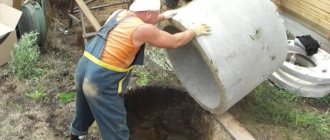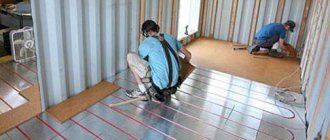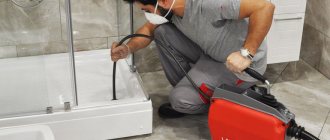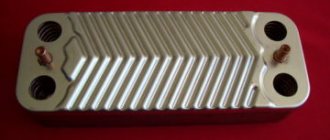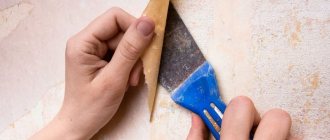Of course, not everyone knows how to weld parts correctly; they have to use the services of professional welders. But if you really want to, you can learn how to weld parts with your own hands.
Electric welding is considered the simplest. This is where the study of the welding process begins. Only after gaining some experience in obtaining a good seam can you begin to perform complex work. Let's get acquainted with the basics of the welding process and its nuances.
Preparatory work
Before welding begins, the parts are first straightened and then cleaned well. Moreover, it is necessary to clean the parts before starting assembly of the unit. The appearance of weld defects is usually associated with various types of contamination:
- Rust;
- Oils;
- Scale.
It is very important to thoroughly clean the metal where welding work will be carried out. This applies to the edges of each part. Any contamination in the gap between the parts being welded must be removed. You can burn off the dirt with a strong flame of a burner or blow it with a powerful stream of compressed air.
You can clean the surface in a variety of ways:
- A brush with metal bristles;
- Needle cutters;
- Hydrosandblasting systems;
- Fraction;
- Burner;
- Grinding wheel;
- Etching;
- Solvent.
After preparing the tools and material, let's figure out step by step how to properly weld with electric welding.
Preparation
A significant point in how to make a beautiful seam when welding is the correct implementation of preparatory work. Since the process is accompanied by the appearance of fire, it is necessary to carefully prepare the workplace of the welder performing the work. Provide him with protective clothing and a mask. There should be no flammable objects or materials near the work site.
The product to be welded must be cleaned of dirt, dust, paint stains, grease and oil residues on its surface. In addition to mechanical impact, the use of solvents or alcohol is permissible.
If welding equipment is used, you should first check its functionality. Then select a mode and set the necessary parameters. If the device malfunctions, its operation is strictly prohibited.
Excitation of the welding arc
There are several ways to initiate an arc.
Option 1. The welder should touch the metal surface with the tip of the electrode, then quickly move it back a few millimeters (2 - 4). As a result, an arc will appear. Its length is maintained by slowly lowering the electrode. It all depends on the amount of melting. Before an arc forms, the worker's face must be covered with a protective shield.
Option 2. You can excite the welding arc in another way. The welder quickly runs the tip of the electrode along the metal surface, then also quickly raises it a couple of millimeters. An arc will appear between the electrode and the metal surface. When welding, you should strive to maintain a very short arc. Small drops of metal will form near the seam. The melting of the electrode will be smooth and calm. The seam is deep and durable.
If the arc size is too long, the base metal will not melt well enough. During welding, the metal of the electrode will begin to oxidize and strong splashes will appear. The seam after such welding will be uneven, with numerous oxide inclusions.
The length of the arc can be easily determined by the sound of its burning. If the length has standard values, the sound will be monophonic and uniform. A very long arc will begin to make sharp sounds, which will be constantly accompanied by strong pops.
If the arc breaks, it is excited again. The crater where the arc broke is carefully welded. If it is necessary to weld a very important unit that will be operated under an alternating load, and “fatigue” may also occur, it is strictly forbidden to excite an arc directly on the surface of the base metal.
If the excitation does not occur along the seam, a “burn” of the metal may occur. At this point, the seam may simply collapse during operation of the part.
Selecting a mask
No matter how welding is performed, it is an unsafe process that can cause significant damage to the health, in particular the vision of the welder. A necessary accessory is a mask that will protect against possible sparks hitting the face, neck and eyes and causing burns.
The mask protects against ultraviolet and infrared radiation. It will also protect against the possibility of hot metal particles getting on the skin and eyes and from harmful gas fumes. A mask is an integral part of a welder’s equipment, regardless of whether he has many years of experience or whether he is taking on such work for the first time.
There is a large selection of masks on sale. However, in addition to the type of this type of protection, it is necessary to choose the right size. The mask should fit tightly on your head and not fall off at the most inopportune serious moment. Otherwise, instead of protection, it will become a thing that poses additional danger.
A mask that is small for a particular person will also not work. Ideally, the mask should fit tightly on your head and not fall off. Therefore, it makes sense to purchase it not online, but during a personal visit to the store.
The welding helmet contains a transparent viewing window through which it is possible to observe the welding process. This window is covered with plastic or tinted glass. The most basic types of masks include welding goggles.
The open look is similar to regular glasses that have special lenses. The closure type has the ability to be fixed with an elastic band. Mineral glass or polycarbonate are used to cover the window. Most models have glass anti-fog protection. The disadvantage is the exposed areas of the face and neck. In order to learn welding, it is recommended to purchase other types of face protection. A good protection option is protective masks.
The advantage of a welding helmet is complete protection of the face, eyes and neck. Preference should be given to those types that are mounted on the head, rather than those that have to be held in the hand.
It must be taken into account that during welding, from time to time it is necessary to inspect the intermediate results of the work or replace a burnt electrode. To do this, you have to free your face from the mask, which is extremely inconvenient. This type of protective mask, such as the “Chameleon”, solves this problem.
This can be considered a breakthrough in the field of welder equipment, and gives him a lot of convenience, being the most convenient option that uses automatic adjustment of glass tinting. A crystal-based filter allows only visible rays to pass through, and blocks ultraviolet and infrared rays. There is thorough neck protection. The mask fits tightly on the head, but without unnecessary tension, thanks to the position regulator. The presence of ventilation prevents the glass from fogging up.
The main important function is performed by the auto-dimming regulator. Thanks to its presence, the welder can not remove the mask from his head or lift it. The mask itself monitors the light level thanks to the presence of polarizing filters. When welding occurs, the glass acquires maximum darkness, and when exposure to bright light ceases, it becomes more transparent. The filter will also react to changes in the brightness of the arc.
Masks of this class are lightweight. The advantages include the possibility of a wide overview. Welding work for beginners is recommended to be done in such universal masks, which will ensure maximum safety.
You should not leave anything unprotected, so in addition to the mask, you should take care of thick clothing, canvas mittens, strong shoes and a durable hat. The ideal option would be to purchase a special suit made for protection during welding.
How rollers are made
The electrode is inserted into the holder. To cause a current to appear in the melting area, it is enough to scratch the surface of the metal with the tip of the electrode, or simply knock several times on the workpiece.
When an electric arc appears, the electrode is directed to the workpiece, maintaining a constant gap between the metal surface and the electric arc. The gap should have a constant value and be in the range of 3–5 millimeters.
Important! To obtain a high-quality seam, it is necessary to maintain the same arc length at all times. If you change this value, the arc may be interrupted and the seam will have many defects.
The direction of the electrode is made at a certain angle relative to the plane of the workpiece. The most optimal angle is considered to be 70 degrees. The inclination does not have a specific value, the main thing is that the welder is comfortable. During the work process, the welder himself finds the optimal position for himself, depending on the specificity of the work being performed.
During such practical exercises, you need to learn how to correctly select the current strength so that the supply remains stable all the time. If there is not enough current, the arc will constantly go out. With a very powerful flow, metal penetration will begin. Only through experimentation can you learn how to correctly set the welding mode.
Courses for welders
Welding can be mastered in special courses. Welding training is divided into theory and practical classes. You can study face-to-face or remotely. The courses teach welding technology for beginners and other important wisdom. It is important to have the opportunity to learn how to weld in practical classes under the supervision of a teacher. Students are given an idea of the available welding equipment, the choice of electrodes, and safety rules.
You can study according to an individual program or together with a group. Each option has its own advantages. When studying individually, you can only acquire knowledge that can be useful in the future. But when studying in a group, you have the opportunity to hear an analysis of the mistakes of your fellow students and thus acquire additional knowledge.
After completing courses and passing exams confirming acquired knowledge and practical skills, an approved certificate is issued.
Technique for obtaining a good weld joint
When the rollers begin to turn out smooth, you can try to start making connecting seams. This operation can be performed by a fairly experienced trainee who knows how to weld using electric welding.
The electrode is ignited according to the technology described above. The only difference will be the movement of the welder's hand. She will perform oscillatory movements. The melt will seem to move from one surface of the part to another. Movement can occur along several trajectories:
- Zigzag;
- Loop-shaped;
- Herringbone;
- With a sickle.
For training, you can take a small metal blank. Draw a line along the surface with chalk so that it can be seen through the dark glass of the mask. It is along this that you need to move the electrode in order to get a kind of seam, in the form of any of the above paths.
After the seam has cooled, you need to beat off the slag with a hammer and examine the work done.
When you have a little experience, you can begin to make connecting seams, which have several types:
- T-bars;
- Butt;
- Angular;
- Overlapping.
In addition, such seams can be horizontal and vertical, and can be welded in different directions.
Only after numerous trainings can you achieve uniform hand movement. After this you can get beautiful details.
How to continue welding after it has stopped?
Since it is impossible to weld a long seam with electric welding without stopping, you have to change the electrode or there were other reasons for the interruption, then at the site of the stop you get a small depression, called a crater. To resume operation, you must perform the following steps:
1. The arc should not ignite on the crater itself. It is necessary to retreat 12 mm from it. Then it is slowly moved towards the crater.
2.The crater itself is carefully welded using oscillatory movements.
3.After this, you can continue welding, maintaining the set mode. To obtain a reliable connection, welding must have several layers:
- Workpiece, 6 mm thick – 2 layers;
- With a thickness of 6–12 mm – 3 layers;
- If the metal thickness exceeds 12 mm - 4 layers.
The movement of the electrode in each layer should be the same. The welding seam, after completion of the operation, is processed, removing all excess.
Movement of the holder
For proper welding, it is necessary to hold the tip of the electrode core at a distance of at least 2 mm and see the weld pool.
The problem for beginners is the need to perform several actions at once. To better fill the joint bead, it is necessary to guide the electrode in several ways.
For welding metal whose thickness is more than 6 mm, it is better to use a triangle motion. And for parts less than this thickness, it is better to use a broken zigzag welding line.
At first, only these methods of guiding the electrode will be required. Pay attention to the constant size of the oscillatory movements. You may first need to simply guide the electrode in a straight line to gain proficiency.
Don't think that you will succeed on the first try. This is a long process, so you need to be patient while mastering the basics.
How are vertical seams made?
Figure 69a shows vertical welding. Since welding a vertical seam using electric welding is quite problematic due to the fact that drops of the melt tend to fall, it is necessary to weld such seams using a short arc. Surface tension prevents drops from immediately rolling down. They fall into the crater faster.
The tip of the electrode is removed from the drop so that it becomes solid. Vertical welding should start from the bottom, gradually moving upward. The underlying crater will prevent drops of metal from falling. See Figure 69c. During operation, you can tilt the electrode. When it is tilted down, the welder sees how the drops are distributed in the area where the seam is being cut.
When it is necessary to perform vertical welding, start from the top point, the electrode must be installed in position I. See Figure 69d.
When the drops begin to fall, the electrode is set to position II. The drop will not drain; the short arc will not allow it.
The most suitable electrode diameter for vertical welding is considered to be 3 – 4 mm. The current should not be very high, approximately 160 amperes.
To achieve minimal melt flow when horizontal seams are welded (see Figure 70, a), the edges are beveled at one upper part.
The arc should be excited at the lower end (position I). Then the arc is transferred to the end of the upper part (position II). The flowing drop begins to rise.
How the end of the electrode should move when single-layer horizontal welding is performed can be seen in Figure 70a, on the right side.
Horizontal seams are allowed to be welded in the form of longitudinal ridges. The very first one should be cooked with a 4 mm electrode, and all the rest with a diameter of 5 mm.
These are the main nuances that will allow you to correctly weld a vertical seam using electric welding.
How to electric weld a ceiling seam
Frequently asked question: how to weld a ceiling seam using electric welding, because it drains? The answer is simple: such seams are welded with a short arc. The welding electrode must have a refractory coating. When the welding process occurs, a cap appears at the end, which does not allow drops of metal to roll down. (See Figure 70, b). During operation, the end of the electrode is evenly removed and then brought closer to the part to be welded. When removed, the arc immediately goes out and the seam begins to harden. To perform ceiling welding, regardless of direction, use only electrodes of small diameters. The current strength decreases (10-12%) when compared to welding of metal of similar thickness produced below.
When ceiling seams are welded, gas bubbles begin to float up. They end up at the very root of the seam. This affects the strength and quality of the welded joint.
The use of ceiling welding is limited. It is remembered when it is impossible to get a seam from the lower position.
What you need to know and where
In order to learn how to weld on your own, you need to learn how to weld, how to work with welding machines for beginners, how to learn to weld metal and other welding secrets.
It is useful to watch a video where a master class on metal welding is conducted. There you can clearly see how to work with welding for beginners. These welding lessons for beginners will help you quickly understand how to learn to weld. Visual welding lessons will provide an invaluable service in learning how to weld on your own.
A manual on welding for beginners will help you understand how to learn how to weld by welding, namely, how to learn how to weld by welding from scratch.
Another way to learn welding is to work with an experienced welder who can point out possible mistakes and give tips on how to correct them.
How fillet welds are welded
The molten metal during this welding will flow down. The optimal way to weld such seams from the bottom position is considered to be “in a boat”. The part is installed in such a way that slag does not leak directly in front of the arc. (See Figure 68, a).
When a fillet weld is welded, with the bottom plane positioned horizontally, sometimes the corner vertices are poorly welded.
The reason for the formation of such a lack of penetration may be the start of the welding process from a sheet standing vertically. The molten metal begins to flow down onto the sheet, which has not had time to warm up well. That is why such seams need to be welded from the bottom plane. Moreover, the arc must ignite at a certain point (A). The movement must be carried out according to the diagram in Figure 68 b.
The electrode is tilted at 45 degrees in relation to the parts being welded. During welding, you need to tilt the electrode slightly in different directions. (See Figure 68 c).
If fillet welds are not welded “in a boat”, the welding is done in a single layer, with a weld leg less than 8 mm. If the size of the leg exceeds this value, several layers are performed.
To weld multiple layers of a fillet weld, you must first create a narrow bead. To do this, use a 3-4 mm electrode. This diameter allows the root to be completely boiled.
To determine the number of passes, take into account the size of the cross-sectional area of the existing seam. Typically this value is 30-40 square meters. millimeters. Figure 68 g clearly shows how fillet welds with different numbers of layers, having grooved edges, and fully welded should look like.
Basic rules for joining parts
After you have mastered the basics of welding, you need to weld metal structures yourself and move on to performing simple assembly and tack operations at home. As a rule, a home craftsman does not weld thick metal, so cutting edges is not required. First, you can practice connecting a profile pipe. To do this, you will need to cut sharp corners at the ends of the parts for a larger penetration area.
The parts are inserted into the corner clamp and secured with a clamping bar. Now you need to first grab it from several sides. To do this, light an arc and place a small point.
There is no need to withstand a large leg, you just need to fix the parts. After checking the diagonals, tacks are performed on all accessible sides. Now the structure is removed and welded with a reliable and high-quality seam.
If the lessons on the angle of inclination and laying metal in a molten weld pool are well learned, then the operations of assembling metal structures will not cause difficulties even for dummies in welding.
Having studied the basics of welding and gained theoretical knowledge, you need to practice as often as possible, put on welding equipment, turn on the welding machine and hone your skills for a long time. Only practice will allow you to become a high-class welder.
How butt seams are welded
If the edges are not beveled, the bead applied should have a slight flare on each side of the joint. To prevent lack of penetration, it is necessary to create a uniform distribution of molten metal.
Only the correct setting of the current and the competent selection of electrodes will allow for good welding of 6 mm metal if the parts do not have beveled edges. The current value is selected experimentally. Why are several test strips welded?
If the parts have V-shaped bevels, the butt weld can be a single layer or have multiple layers. The main role in this issue is played by the thickness of the metal.
When one layer is welded, the arc should be excited at point “A”, at the bevel boundary, according to Figure 67a. After which the electrode is lowered down. The root of the seam is completely boiled, then the arc is sent to the next edge.
When the electrode moves along the bevels, its movement is specially slowed down to ensure good penetration. At the root of the seam, on the contrary, they speed up the movement to prevent a through burn.
On the reverse side of the welding joint, professionals advise applying an additional weld seam.
In some cases, a 2-3 mm steel lining is mounted on the opposite side of the seam. To do this, increase the welding current by about 20–30% relative to the standard value. In this case, through penetration is completely excluded.
When the weld bead is created, the steel backing is also welded. If it does not interfere with the design of the product, it is left. When welding very important structures, the opposite side of the root of the weld is welded.
If you need to weld a multilayer butt seam, the root of the seam is welded first. For this purpose, electrodes with a diameter of 4–5 millimeters are used. Then the next layers are surfaced with expanded beads, for which large-sized electrodes are used (See Figures 67, b, c).
Selection of welding electrodes
To choose the right electrode, you need to consider several important parameters:
- Workpiece thickness;
- Steel grade.
Depending on the type of electrode, the current value is selected. Welding can be done in a variety of positions. The lower one is divided into groups:
- Horizontal;
- Tavrovaya.
Vertical type welding can be:
- Down up;
- Ceiling;
- Tavrovaya,
Each manufacturer, in the instructions for the electrodes, must indicate the value of the welding current at which they will work normally. The table shows the classic parameters used by experienced welders.
The magnitude of the current is influenced by the spatial position, as well as the size of the gap. For example, to work with a 3 mm electrode, the current must reach 70–80 amperes. This current can be used to perform ceiling welding. This will be sufficient for welding parts when the gap size is much greater than the diameter of the electrode.
To cook from below, in the absence of a gap and the appropriate thickness of the metal, it is allowed to set the current strength to 120 amperes for an ordinary electrode.
Welders with extensive experience recommend using a certain formula for calculations.
To determine the current strength, 30–40 amperes are taken, which must correspond to one millimeter of the diameter of the electrode. In other words, for a 3 mm electrode you need to set the current to 90-120 amperes. If the diameter is 4 mm, the current will be 120–160 amperes. If vertical welding is performed, the current is reduced by 15%.
For 2 mm approximately 40 - 80 amperes are set. Such a “two” is always considered very capricious.
There is an opinion that if the diameter of the electrode is small, it means it is very easy to work with. However, this opinion is wrong. For example, to work with a “two” you need a certain skill. The electrode burns quickly and begins to get very hot when the current is set to high. With such a “deuce” you can weld thin metals at low current, but experience and great patience are required.
Electrode 3 - 3.2 mm. Current strength is 70–80 Amperes. Welding should be carried out using direct current only. Experienced welders believe that above 80 amperes, it is impossible to perform normal welding. This value is suitable for cutting metal.
Welding should start at 70 Amps. If you see that it is impossible to weld the part, add another 5-10 Amps. If there is a lack of penetration of 80 amperes, you can install 120 amperes.
For welding on alternating current, you can set the current strength to 110-130 amperes. In some cases, even 150 Amperes are installed. Such values are typical for a transformer apparatus. When welding with an inverter, these values are much lower.
Electrode 4 mm. Current strength 110-160 Ampere. In this case, the spread of 50 amperes depends on the thickness of the metal, as well as your work experience. "Four" also requires special skill. Professionals advise starting with 110 amperes, gradually increasing the current.
Electrode 5 millimeters or more. Such products are considered professional and are used only by professionals. They are mainly used for surfacing metal. They practically do not participate in the welding process.
Why are electrodes calcined?
This is done for only one purpose, to remove moisture. When welding with a raw electrode, welding seam defects may occur. Such an electrode will stick to the part all the time.
Every construction company must install equipment that pierces electrodes. This operation is not available to amateur welders.
If you started working with a new pack, but were unable to use it up completely, the remaining number of electrodes should be hidden in a dry and warm place. Never store electrodes in the basement or attic. They will quickly become damp and unusable.

